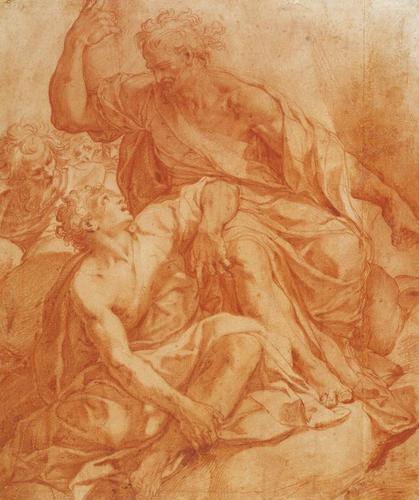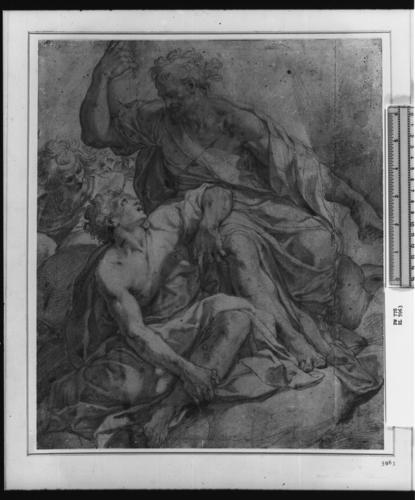An old man and a youth c.1585
Red chalk | 37.8 x 31.7 cm (sheet of paper) | RCIN 905963
-
A drawing of an elderly man admonishing a youth seated at his feet.
The drawing corresponds with two figures in Procaccini’s first major fresco, the Last Judgement in San Prospero, Reggio Emilia. It is unusually close in detail to the fresco, including the background elements; this would normally indicate a copy, but the style is Procaccini’s and there can be little doubt about his authorship. Perhaps the patrons were not confident about the young artist’s ability to see through a project of this scale, and required him to produce unusually explicit preparatory drawings.
Camillo Procaccini was born in Bologna, and had enrolled as a student in the painters’ guild by 1571. Little is known of his youthful work before a visit to Rome around 1580, but the scale of the commission for which this work is a study - the Last Judgment frescoed in the apse of San Prospero in Reggio Emilia - implies that by the mid-1580s he had already attained a significant reputation.
The project is unusually well documented. In 1576 Lelio Orsi was paid for a design for the scheme, but his quotation of 1,000 scudi to carry out the work, in collaboration with Bernardino Campi, was deemed too high. The canons began to look around for other artists: in March 1583 they approached Federico Zuccaro in Rome to see if he would be willing to paint the apse, following Orsi’s design. The answer was clearly no, for a year later Procaccini arrived in Reggio ‘to see the choir to be painted’. But the canons still wished to consult the elderly Orsi, who was living in Novellara, and then sent agents to Sabbioneta to evaluate the work of Bernardino Campi, perhaps nervous to entrust such a commission to a young artist. It was not until 9 January 1585 that a contract was finally signed with Procaccini, to execute the work within two years to his own designs, those of Orsi evidently having been discarded. Work on the frescoes began that April, after the artist had been sent to Parma to study paintings there, no doubt primarily those by Correggio and Parmigianino.
In September 1586 Procaccini asked for six weeks’ leave to visit Milan, where his father and brothers were now based. Probably believing that he intended to abandon the project, the canons refused him permission, threatening him with imprisonment, and Procaccini pressed on until November 1587, when he was allowed to suspend work having frescoed the apse and its vault (and leaving unfinished a second project in San Prospero, in the chapel of the Confraternity of Saint Roch). The canons’ fears were well founded, for Procaccini failed to return to Reggio, and they turned to Bernardino Campi and (after Campi’s death in 1591) to Giovanni Battista Tinti to continue the work. Finally in April 1597 Procaccini returned to Reggio to fresco the remainder of the vault, and by October 1598 the project was complete.
This drawing corresponds with a group to the lower left of the Last Judgement. The figure style of the fresco, of this drawing, and of another in Jerusalem for a further group in the fresco, strongly evokes the precedent of Pellegrino Tibaldi’s Bolognese paintings of a generation earlier, in particular his frescoes in the Palazzo Poggi. The drawings are unusually large and elaborate for figure studies of this period, and there remains a question about the status and function of these sheets, which have some of the features typical of copies - not only the exact correspondence with the painting, but also the heads and clouds in the background, the sort of pictorial setting that is rarely met with in a preparatory drawing. The style, however, is exactly that of Procaccini, and there can be little doubt about his authorship of these drawings. Perhaps the nervousness of the patrons about Procaccini’s ability to see through a project of this scale led him to produce unusually explicit preparatory drawings, to put their minds at ease; alternatively, these may have been finished drawings executed by Procaccini for what seems to have been a growing collectors’ market for drawings in Emilia. Apparently Procaccini kept some version of the drawing with him, for these two figures formed the basis for the youths perched in a tree in his Triumph of David, one of the huge organ shutters painted in 1592-5 for the Duomo of Milan.
Catalogue entry adapted from The Art of Italy in the Royal Collection: Renaissance and Baroque, London, 2007Provenance
Royal Collection by c.1810 (Inventory A, p. 54, Pellegrino Tibaldi, Primaticcio, Procaccini &c., '2. An emblematical Subject. A capital Drawing engraved by Francesco Bartolozzi...Pelegrino Tibaldi').
-
Creator(s)
-
Medium and techniques
Red chalk
Measurements
37.8 x 31.7 cm (sheet of paper)
Object type(s)











